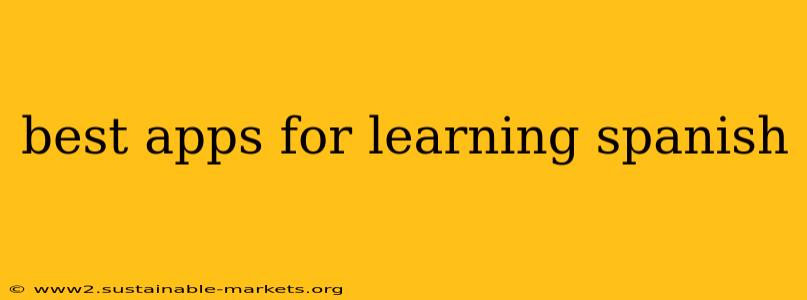Learning a new language can be a rewarding journey, opening doors to new cultures and experiences. If Spanish is your target language, you're in luck! There's a plethora of fantastic apps available to help you on your path to fluency. This guide dives deep into some of the best, categorized for your convenience, helping you choose the perfect app to match your learning style and goals.
Top Apps for All Learning Styles
This section highlights apps suitable for various learning preferences, from visual learners to those who thrive on gamification.
1. Duolingo: The Gamified Language Learning Giant
Duolingo's popularity is well-deserved. Its gamified approach makes learning fun and engaging, with points, streaks, and leaderboards to keep you motivated. Duolingo offers a comprehensive curriculum covering vocabulary, grammar, and pronunciation, using a mix of multiple-choice questions, writing exercises, and speech recognition. It's excellent for beginners, providing a solid foundation in Spanish.
Pros: Free version with substantial content, gamified learning, user-friendly interface. Cons: Can sometimes oversimplify grammar explanations, limited focus on cultural aspects.
2. Babbel: A Focus on Practical Conversation
Babbel differentiates itself with its focus on practical conversational skills. Its lessons are designed to equip you with the phrases and vocabulary you'll actually use in real-life situations. Babbel emphasizes contextual learning, placing words and phrases within realistic scenarios. It also provides excellent pronunciation exercises with feedback.
Pros: Emphasis on practical conversation, high-quality audio and video lessons, structured curriculum. Cons: Free trial is limited, subscription costs more than some competitors.
3. Memrise: Mnemonics and Memorable Learning
Memrise employs a unique approach, utilizing mnemonics and memorable images to help you retain vocabulary. The app incorporates flashcards, games, and spaced repetition techniques, optimizing memory recall. Its user-generated content also adds a diverse range of learning materials.
Pros: Effective memory techniques, user-generated content adds variety, fun and engaging learning experience. Cons: Grammar explanations can be less comprehensive than other apps, reliance on memorization might not suit all learners.
Specialized Apps for Specific Needs
Beyond the general-purpose apps, consider these specialized options that cater to specific needs:
4. Rosetta Stone: Immersive Language Learning
Rosetta Stone takes an immersion approach, focusing on associating images and sounds with words without direct translation. This method promotes intuitive language acquisition, although it might be challenging for some learners.
Pros: Immersive learning experience, emphasis on intuitive understanding. Cons: Can be more expensive than other options, less emphasis on grammar explanation.
5. HelloTalk: Language Exchange Partner App
HelloTalk is unique in that it connects you with native Spanish speakers for language exchange. You can practice speaking with real people, receiving feedback and improving your conversational skills.
Pros: Real-life conversation practice, cultural exchange opportunities. Cons: Requires active participation and finding reliable language partners.
Choosing the Right App for You
The best app for learning Spanish depends on your individual preferences and learning style. Consider these factors:
- Your budget: Some apps offer free versions with limited content, while others require a subscription.
- Your learning style: Do you prefer gamified learning, immersion, or a more structured approach?
- Your goals: Are you aiming for conversational fluency, or are you focusing on reading and writing?
Experiment with a few different apps to find the one that best suits your needs. Many offer free trials, allowing you to test them out before committing to a subscription.
Beyond the Apps: Supplementing Your Learning
While apps provide a great starting point, remember that effective language learning often requires a multifaceted approach. Supplement your app learning with:
- Spanish language media: Watch movies and TV shows, listen to music and podcasts.
- Real-life interaction: Practice speaking with native speakers whenever possible.
- Formal classes: Consider supplementing your app learning with a formal class for more structured instruction.
With dedication and the right tools, mastering Spanish is within your reach. Choose the app that best fits your needs and embark on your exciting language learning journey!

